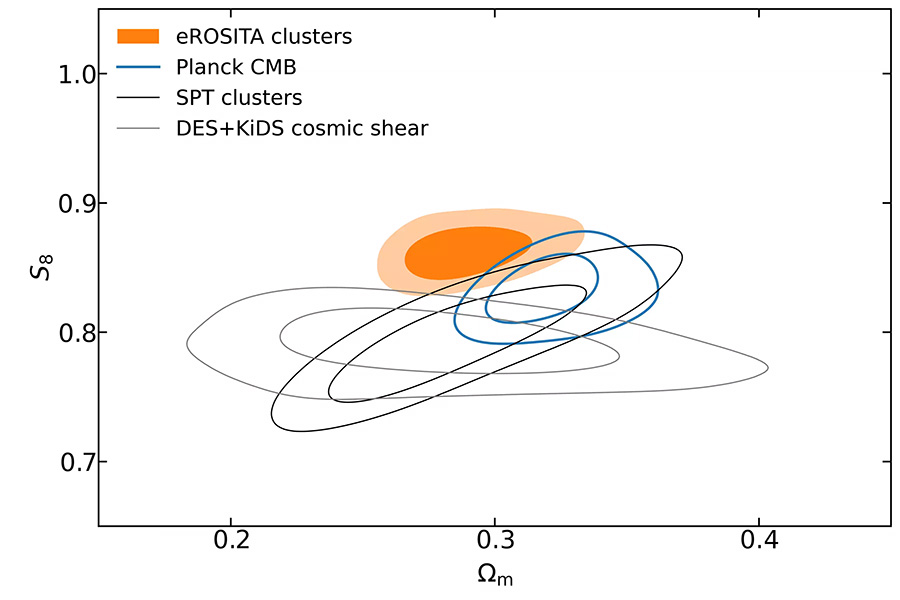Results from a brand-new high-energy observatory are rocking the field of cosmology. In particular, a study of more than 5,000 galaxy clusters relieves tension in the standard cosmological model.

MPE / M. Kluge and C. Garrel for the eROSITA consortium
The team behind the X-ray observatory eROSITA has just released a dataset of 900,000 distinct high-energy sources — the largest X-ray catalog ever published. Alongside the catalog, the consortium also released a series of scientific papers covering a broad range of topics — including one study, led by Vittorio Ghirardini (Max Planck Institute for Extraterrestrial Physics, Germany), that delves into the evolution of the largest structures in the universe.
Ghirardini’s team probes the mass of 5,259 galaxy clusters surveyed by eROSITA, presented in a paper to appear in Astronomy & Astrophysics. They then investigate how those masses change over time to pin down various parameters in the standard cosmological model.

MPE / J. Sanders for the eROSITA consortium
This model, also called Lambda Cold Dark Matter (LCDM), explains the evolution of the universe in terms of three major components: dark energy, described by the constant lambda; cold dark matter; and ordinary matter.
“The [researchers] look at a combination of how much each cluster of galaxies is bending the light behind it, and how brightly the gas inside it emits X-rays, and use that to estimate how much mass might be in each individual cluster. They then add up all that mass,” summarizes Cullan Howlett (University of Queensland), who is not part of the collaboration.
This method differs from previous studies, which have used weak gravitational lensing. This technique involves looking at how massive clusters bend the light coming from background galaxies, subtly warping those galaxies’ shapes. The cluster's mass is calculated based on a statistical analysis of the shape changes. The study posits that tallying X-ray-emitting matter is a more accurate method of measuring cluster mass than weak lensing, which might be prone to systematic errors.
Ghirardini’s group was interested in how matter density is distributed over large scales. Astronomers quantify this distribution in a parameter called sigma-8 (S8); higher values of S8 indicate a universe where matter clumps together more, while lower values correspond to a smoother distribution of matter.
Previously, galaxies seemed to cluster differently in the early universe as compared to nearby. This disagreement has been called the S8 tension. But eROSITA sees no sign of it.
“Interestingly, we do not see any hint of S8 tension,” says Esra Bulbul (Max Planck Institute), “or any departures from the standard model of cosmology, the cold dark matter model with a dark-energy component (LCDM).”
So far, eROSITA is the only probe of the relatively nearby universe that does not report that tension. The study also produced tighter constraints on other parameters in the LCDM model, such as the dark energy equation of state; they found w to be between -1 and -1.24. The value of w determines the nature of dark energy, and different values have different ramifications for the fate of the universe. Bulbul says this is the most precise measurement of w from a cosmology probe alone. The value is consistent with the recent results from the Dark Energy Survey (within the error bars for both probes).

MPE / V. Ghirardini for the eROSITA consortium
This groundbreaking cosmology study is just one of almost 50 new scientific publications just released by the German eROSITA Consortium, which consists of about 250 scientists organized into 12 working groups. The projects are wide-ranging and include the effects of X-ray irradiation on planets, an analysis of the flickering of supermassive black holes, the discovery of a giant filament of warm gas extending between two galaxies, and two new quasi-periodically erupting black holes. All of this from only the first six months of the survey!
“The scientific breadth and impact of the survey is quite overwhelming; it’s hard to put into a few words,” says consortium spokesperson Mara Salvato (Max Planck Institute). “But the papers published by the team will speak for themselves.”
The eROSITA instrument, built by the Max Planck Institute for Extraterrestrial Physics in Germany, is part of Spectrum-Roentgen-Gamma (SRG), a high-energy astrophysics space observatory that launched on July 13, 2019. The joint project between Russia and Germany carries two X-ray telescopes, of which eROSITA is one. However, the German contribution has been on hold since February 2022.
Indeed, eROSITA’s new catalog is all the more remarkable considering all this data comes from just the first of its eight planned all-sky surveys. (Multiple surveys allow the telescope to probe the early universe more deeply.) It is lucky that the telescope has proven so prolific, because in response to Russia’s invasion of Ukraine, Germany put the telescope into a hibernation mode. Only four and a half all-sky surveys had been completed, and it's unclear if the mission will ever be able to finish out the rest.
 0
0









Comments
You must be logged in to post a comment.